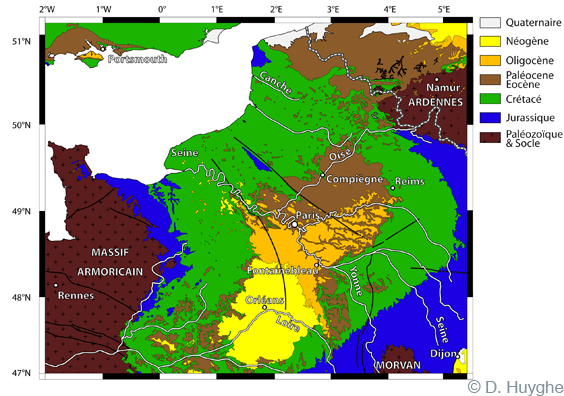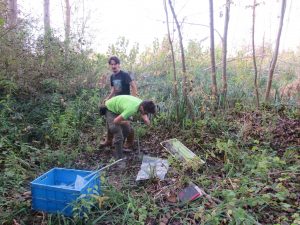Geology-Areas of Interest-The Paris Basin

Because of its location in Fontainebleau, the Geology team of the Centre de Geosciences has a strong foothold in the Paris Basin. Several studies are currently undertaken in the area at different scales and in several domains.
The Paris Basin is a typical intra-cratonic basin -moderately influenced by tectonic processes- where eustatic and climatic cycles have a major impact on sedimentation. It is furthermore an historical place where early stratigraphical and paleontological concepts were developed. It is therefore a suited laboratory to study paleo-climate and paleo-geography, particularly during Cenozoic times.
The Tertiary record is marked by several transgression/regression cycles, which allowed depositions alterning between coastal, lagoon, continental and lacutrine facies. During the Paleogene, the Paris Basin had the most diverse biodiversity known in marine environments. The geochemical analysis of different fossils (mollusks, charophytes, dasycladales) within these sedimentary successions allowed to better understanding paleo-climatic and paleo-environmental variations in such setting, thus representing a precious benchmark to compare with more seismically active areas (ex: Pyrenees; Damien Huyghe, 2010 ).

Building on this work, a new analysis is going on to characterize more precisely the Middle Eocene Climatic Event (MECO) that is thought to be analogous to the current global warming. It is a brief (50 kyrs) global warming event, which is very intense and well documented in the oceanic record but remains less known in coastal series. New isotopic analyzes (δ18O coupled with D47) of this series will allow to better constraining mean annual and seasonal temperature variations on the littoral, as well as the associated sedimentary response of intracratonic areas during such a warming.(RGF, Ph.D. Loïc Marlot).

During the Quaternary period, river networks incise in response to sea level fall associated with large wavelength deformation pattern. Following early work on river networks development and entrenchment, ongoing studies focus on the alluvium of valley bottom, which records geomorphic evolution during the last two glacial periods. The impact of substrate lithology is studied along the Oise valley (RGF, M.Sc. Alexandre Leveque, 2020) while abandoned channel sedimentary architecture are characterized in the Bassée valley (Ph.D. Léo Szewczyk, 2020) and related to fluvial network evolution and usages by men (collaboration PIREN Seine).
 The Holocene is caracterized by anthropogenic processes that interfer with the so-called “natural” dymanics of river systems and their respective catchments. Water and agricultural mangagement, infrastructure, urbanisation, and industrialisation strongly impact these environments. The Geology team develops since several years physico-chemical proxies to caracterize the particle flux in river systems (e.g. Belles et al. 2019; Franke et al. 2009, 2020 ; Kayvantash et al. 2017 ; Patault et al. 2019). These tracers can be used to e.g. quantify erosion of top soil or in the case of assoiated pollutants (heavy metals, pesticides, etc) they allow a better caracterization and monitoring of the substances présent in a given catchement. This ongoing research is the object of the Master 1. project of Nolwen Venisse in cooperation with IFPEN and IMT Lille-Douai (starting Feb. 2021) and two Ph.D. s in the framework of the project GeSS (Morgan Delaporte) and project TracS (Dylan Laurence), started in october 2020. These physico-chemical proxies are also used in the framework of the EcorcAir project (in cooperation PartiCitaE with Sorbonne University and IPGP), mapping the air pollution of fine particles in urbanized areas.
The Holocene is caracterized by anthropogenic processes that interfer with the so-called “natural” dymanics of river systems and their respective catchments. Water and agricultural mangagement, infrastructure, urbanisation, and industrialisation strongly impact these environments. The Geology team develops since several years physico-chemical proxies to caracterize the particle flux in river systems (e.g. Belles et al. 2019; Franke et al. 2009, 2020 ; Kayvantash et al. 2017 ; Patault et al. 2019). These tracers can be used to e.g. quantify erosion of top soil or in the case of assoiated pollutants (heavy metals, pesticides, etc) they allow a better caracterization and monitoring of the substances présent in a given catchement. This ongoing research is the object of the Master 1. project of Nolwen Venisse in cooperation with IFPEN and IMT Lille-Douai (starting Feb. 2021) and two Ph.D. s in the framework of the project GeSS (Morgan Delaporte) and project TracS (Dylan Laurence), started in october 2020. These physico-chemical proxies are also used in the framework of the EcorcAir project (in cooperation PartiCitaE with Sorbonne University and IPGP), mapping the air pollution of fine particles in urbanized areas.
